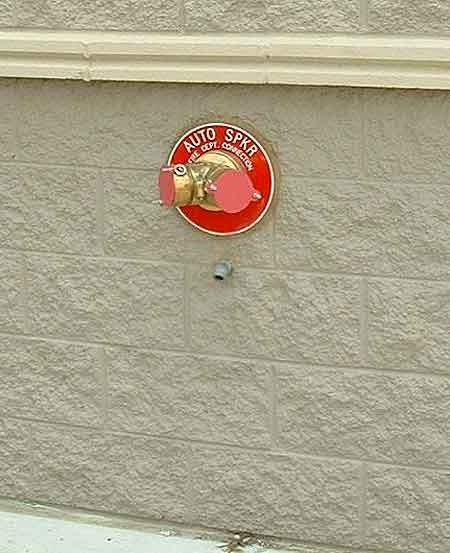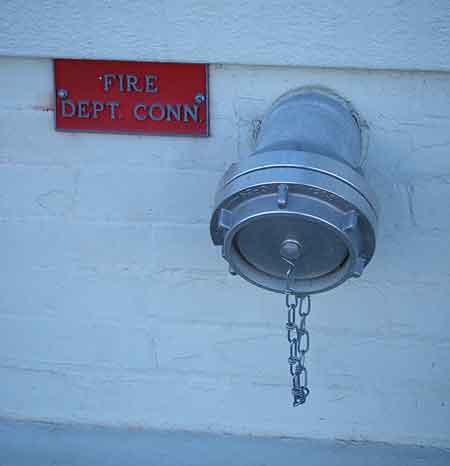By Gregory Havel
A fire department connection (FDC) is required by National Fire Protection Association (NFPA) codes to supplement the city or private water supply to all automatic fire sprinkler systems (except residential systems) and standpipe systems. In the case of “manual wet” and “manual dry” standpipe systems, the FDC is the only source of firefighting water.
NFPA codes that apply to the installation and maintenance of automatic fire sprinkler and standpipe systems include the following:
- NFPA Standard 13, Installation of Sprinkler Systems, 2010 edition
- NFPA Standard 14, Installation of Standpipe and Hose Systems, 2010 edition
- NFPA Standard 25 Inspection, Testing, and Maintenance of Water-Based Fire Protection Systems, 2011 edition
- NFPA 1, Fire Code, 2012 edition
- NFPA 101, Life Safety Code, 2012 edition

(1)
Photo 1 shows the traditional style of FDC: the siamese with two 2.5-inch female connections. The caps shown are of die-cast metal and are designed to be broken with a spanner or other tool for quick access during an incident. A standpipe system FDC would be identical to this one, except that the sign would read “STANDPIPE” rather than “AUTO SPKR.” A similar type of connection with a single 2.5-inch connection is used on small systems in some jurisdictions. FDCs with more than two 2.5-inch connections can be used on large systems if required by the authority having jurisdiction.

(2)
Photo 2 shows another style of FDC, with a single 5-inch threadless connection, for use with large-diameter hose. This style is being used in many jurisdictions, especially at industrial buildings and big-box stores.

(3)
Photo 3 shows a third style of FDC used in some parts of the United States. This style of FDC is usually located outside the collapse zone of the building and near a hydrant. It incorporates both the traditional 2.5-inch siamese and 5-inch threadless connections for versatility, but requires underground piping and a pit near the building for the FDC drain. Its primary advantage is that the pumping apparatus is outside the building’s collapse zone and will not become an exposure to the fire.
The variation in size and number of connections on FDCs is discussed in NFPA 13 in Article 6.8 and in NFPA 14 in Article 4.8. The authority having jurisdiction decides on the type and size of connection to be required.
Unless all of the FDCs in your response area use the same size and type of hose connection, firefighters should note on the facility prefire plans which connection is used at that location. Ensure that any adapters or fittings needed for connection are carried on all of your pumping apparatus.
Download this article as a PDF HERE.


